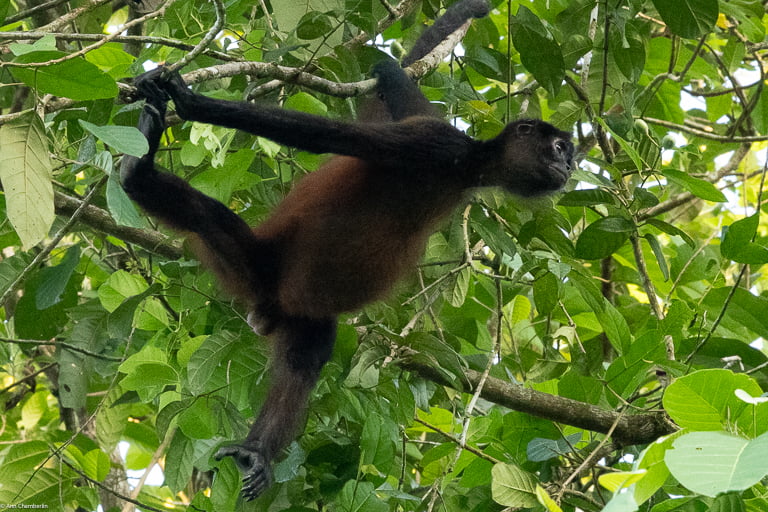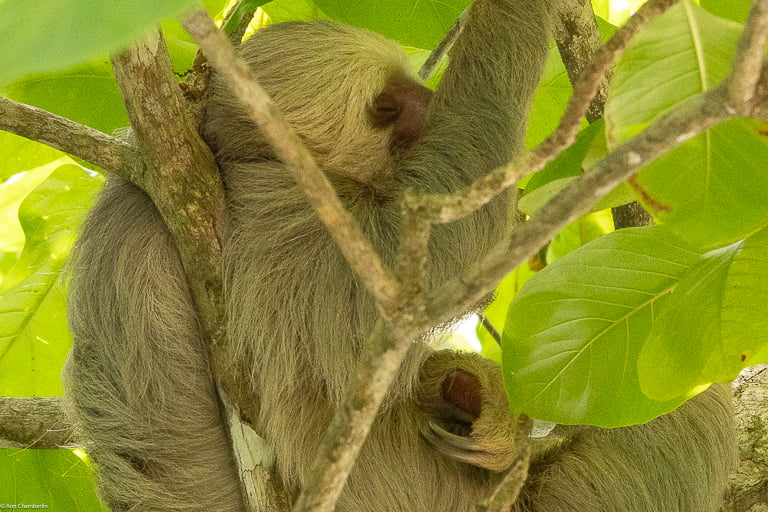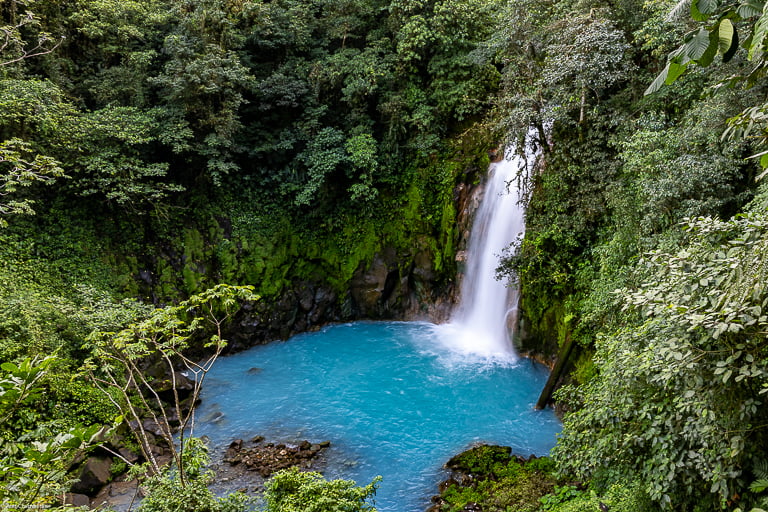Rio Celeste Waterfall
Costa Rica has many amazing waterfalls. You can find entire websites dedicated just to reviewing and ranking them. We only had time for one and chose Rio Celeste. We are glad we did – it’s stunning. Located within Tenorio Volcano National Park, it does take some planning. The last entry is at 1:45, to ensure everyone has enough time to walk the entire trail and leave before dark. Entrance tickets to the park can only be purchased online (buy them here), so you should definitely buy them in advance. There is very limited wifi access near the park entrance, but it didn’t work for us. We ended up buying a ticket from a local and paying a $3/ticket surcharge.
We recommend hiking to the end of the trail first, to the Teñidero, where two streams converge and create the teal color. Visit the waterfall at the end, as it’s 252 steps down to the bottom viewing platform and you won’t want to keep hiking if you do that first.
La Fortuna
Arenal Volcano is the big draw in this area and most people choose to go to the National Park Visitor Center. We went instead to the Arenal 1968 Viewpoint and Trailhead and were very glad we did. This park entrance offers the same wonderful hikes and views, but with far fewer crowds. Most of the hike we were by ourselves. There is also a cafeteria there, which allowed us to have lunch and appreciate the volcano’s beauty for another hour. Tickets for this park can be purchased at the entrance.
River Rafting. There are numerous rivers in this area and the rafting operators offer trips to suit every level of experience and adventure. We chose the Sarapiqui River White Water Rafting Class IV with Arenal Rafting. They are a very professional group and our guide, Eric was amazing. He grew up on the river and had lots of stories to share about the river and his life on it. The guide to participant ratio is high. Most boats had only 3-4 participants and one guide. This was our favorite activity of the trip.
Canyoning provided us another way to interact with nature, with some adventure thrown in. We chose the combination waterfall rappelling, ziplining and pool jumping package with La Roca Canyoning. We particularly liked rappelling down the waterfalls.
Hot Springs. With the active Arenal Volcano nearby, there are many hot springs in the area. Numerous hotels have built spas around these hot springs and many of them offer day passes. We opted instead to go to the free local option. It is the river just below Tabacon Hot Springs. A local charged us $5 to park on the side of the street. We put our belongings in a dry bag and donned our water shoes/sandals and walked to the river. Lots of people were there soaking in the warm water. It was a communal experience.
Monteverde
Cloud forests are an interesting phenomenon and they are worth seeing. The beauty is in the flora, as it’s hard to see much wildlife in the dense jungle. The nature viewing can be walking in the forest (day and night) or going to specific gardens and sanctuaries.
There are places to see orchids, frogs, bats, butterflies and hummingbirds. For first timers, they’re all worth a visit. Because we’d seen all of this in the cloud forests of Ecuador, we opted to only go to Cafe Colibri, or the hummingbird café. This turned out to be the café and gift shop of the Monteverde Preserve. There were only 4 feeders outside the cafe and lots of tour bus groups, so expect a loud and crowded experience.
The main attraction here is the Monteverde Cloud Forest Biological Preserve. Being only a couple of hours from the cruise ship terminal, the park is flooded with day trip visitors.
Just a few miles away, the Santa Elena Cloud Forest Reserve features the same ecosystem, flora and fauna, but without the crowds. We did a 5 mile hike in the park (they have shorter options as well) and saw only a handful of people. We ran into one guided group, and spotted the tarantula he had found inside a tree, but otherwise nobody was seeing much wildlife.
If it’s wildlife viewing you’re after, we believe your best bet is a night tour like this one: Santa Elena Cloud Forest Night Hike.
Ziplining. The most fun we had was ziplining across canyons and flying like Superman with 100% Aventura. Hot tip, arrive 45 to 60 minutes before your assigned time to make sure you are in the first group. We were in the last group and had to wait up to 30 minutes at various stations because some people in front of us got stuck and had to be pulled to the end of the line.
Final thoughts on Monteverde
Monteverde is a couple hours from the cruise terminal, and it is full of tour buses. The trick is to avoid them by finding restaurants, preserves and activities that don’t have bus parking lots. A couple of years ago, we went to Ecuador’s cloud forest and found that preferable, as the lodges have enough space between them that you can see everything in one location and the only other people you see are the ones in your lodge. Two lodges we recommend are:
Mashpi Lodge. A beautiful lodge tucked away in a very diverse biosphere. Price includes guided day and night tours along with birdwatching. Highly recommended.
Bellavista Cloud Forest Reserve & Lodge. Recommended as a more affordable option
Manuel Antonio
Manuel Antonio National Park is the most visited park in Costa Rica for good reason – it has lots of animals. But don’t think you can find them on your own. We visited the park twice. The first time, we hired a guide and saw 10 different animal species, including 5 sloths. The next day we went on our own and didn’t see any at all. We bought our tickets online directly from the park here, a month before departure. It’s a small park and the slots sell out very quickly. We were told the best time to go is at 7 am, but we think 8 or 9 is better. First, there is more light for pictures. More importantly, by then the 7 am guides have already found all the animals and passed the info along to everyone.
We hired Adventura Macha Tours on our way to the park. Our guide, Antonio, was amazing, but we overpaid the operator. It’s better to contact our guide directly at Cecropia Nature & Adventure Tour (cecropiatour@hotmail.com or What’s App +506-83107611.) Alternatively, you can book a tour with Viator and they will organize everything.
We also booked a Night Boat Tour. Unfortunately, it was a very bright night with a full moon and we saw very little. We’re not sure how much better it could have been, so we don’t recommend it.
Final note on Manuel Antonio. If your plans include visiting the Osa Peninsula and Corcovado National Park, you can skip Manuel Antonio. Corcovado has the same animals, but with no crowds.
Puerto Jimenez and the Osa Peninsula
Sirena Overnight in Corvorado National Park was the highlight of our trip. We saw tapirs, sloths, hawks, monkeys and many, many other animals with our naked eye. Our guide, Gerson from Rainforest Chronicles, was amazing. He’s a former forest ranger and is an incredible animal spotter.




